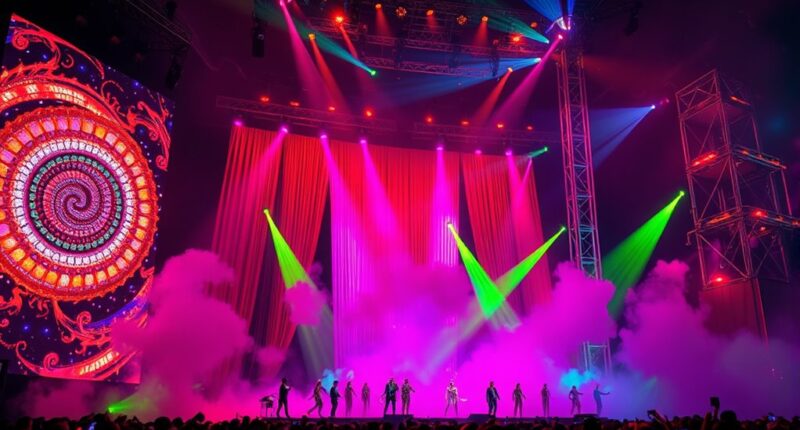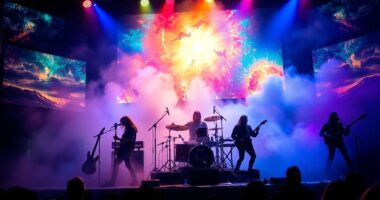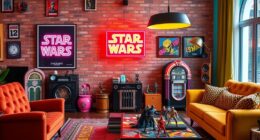To create an immersive live show, focus on understanding your audience and venue to tailor your stage design for maximum engagement. Use lighting, colors, and visual effects to set the mood and guide emotions. Incorporate dynamic set pieces, props, and interactivity to surprise and involve viewers. Integrate technology smoothly with seamless progressions, balancing aesthetics with functionality. Keep refining your approach to captivate your audience consistently—more secrets await those willing to explore further.
Key Takeaways
- Tailor stage design to audience and venue for enhanced engagement and visual impact.
- Use strategic lighting, color schemes, and visual effects to create mood and atmosphere.
- Incorporate dynamic set pieces and interactive props to transform scenes and boost immersion.
- Utilize technology like projection mapping and augmented reality for seamless scene transitions.
- Prioritize sightlines, clear visual cues, and smooth transitions to maintain audience focus and storytelling flow.
Understanding the Audience and Venue
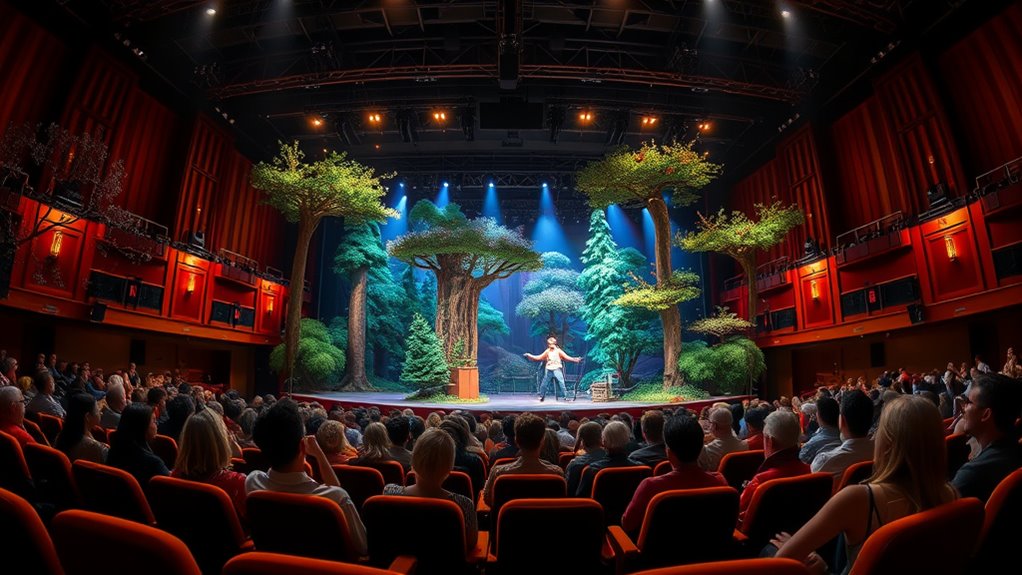
Have you ever wondered why some stage designs resonate so well with their audience? It all comes down to understanding your audience and venue. When you tailor your design to engage the crowd, you boost audience engagement and create a memorable experience. Consider the venue’s acoustics—if you overlook how sound travels and resonates, the message can get lost or distorted. A design that complements the space enhances clarity and ensures everyone feels connected. Think about sightlines, proximity, and how the environment influences mood. By analyzing these factors, you can craft a stage that not only captivates visually but also amplifies sound naturally. Incorporating sound quality considerations ensures your design is truly immersive. This thoughtful approach guarantees your performance leaves a lasting impression and keeps your audience fully immersed.
Utilizing Lighting to Set the Mood
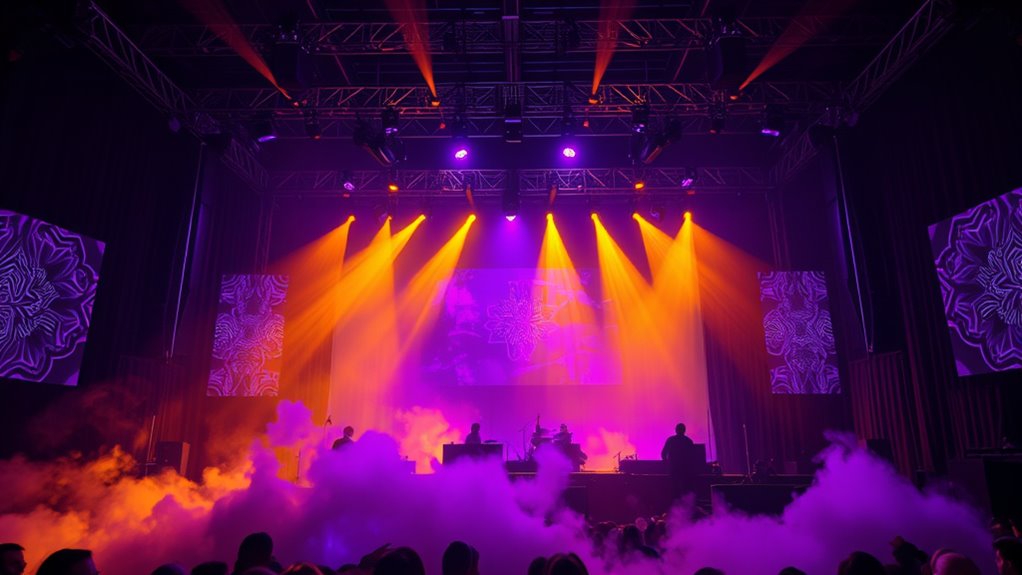
Lighting can transform the atmosphere on stage, so choosing the right colors and effects is essential. You can create mood shifts with dynamic changes that guide the audience’s emotional response. Spotlight and focus techniques help highlight key moments and direct attention exactly where you want it. Additionally, incorporating color psychology can enhance the desired emotional impact of the scene.
Color Choices and Effects
Color choices and effects play a crucial role in shaping the mood of a stage, as lighting can dramatically influence how the audience perceives the scene. By understanding color psychology, you can select hues that evoke specific emotions—warm tones energize, while cool tones calm. Using hue harmony ensures the colors complement each other, creating a cohesive visual atmosphere. For example, combining deep reds and oranges can generate excitement, while blues and greens foster serenity. Consider this table to guide your choices:
| Mood | Color Palette | Effect |
|---|---|---|
| Intensity | Red, Orange, Yellow | Energizes and excites |
| Calmness | Blue, Green | Soothes and relaxes |
| Mystery/Drama | Deep Purple, Dark Blue | Adds intrigue and depth |
Additionally, controlling contrast ratio is vital for ensuring that the visual elements stand out clearly and contribute to the desired emotional impact.
Dynamic Lighting Transitions
Dynamic lighting shifts are essential for shaping the scene’s mood and guiding the audience’s emotional experience. By using stage lighting effectively, you can create seamless crossings that evoke specific feelings or highlight key moments. Color blending plays a vital role here, allowing you to smoothly shift from one hue to another, enhancing the atmosphere without disrupting the flow. For example, warm tones can build excitement, while cooler shades evoke calm or tension. You can also manipulate intensity and focus, changing from bright to dim lighting to signal changes in energy or mood. These progressions keep viewers engaged, making the story more immersive. When executed precisely, dynamic lighting progressions become a powerful tool to deepen the emotional impact of your live show. Additionally, understanding lighting control systems enables designers to create complex and synchronized transitions that elevate the overall experience.
Spotlight and Focus Techniques
Spotlighting is a powerful technique that directs the audience’s attention precisely where you want it, shaping the mood and emphasizing key moments. With well-placed stage lighting, you can create focal points that guide viewers through the performance’s emotional landscape. Use spotlights to isolate a performer or highlight specific actions, making sure the lighting draws the eye instantly. Adjust the intensity and color to match the scene’s tone—warm tones for warmth and intimacy, cool tones for tension or mystery. By controlling how light falls on your focal points, you shape the audience’s perception and deepen their engagement. Effective spotlighting ensures your main elements stand out, while the surrounding areas remain subtly lit or dark, adding drama and focus to your stage design. Additionally, understanding lighting terms can help you communicate your vision more effectively with lighting designers and technicians.
Incorporating Dynamic Set Pieces and Props
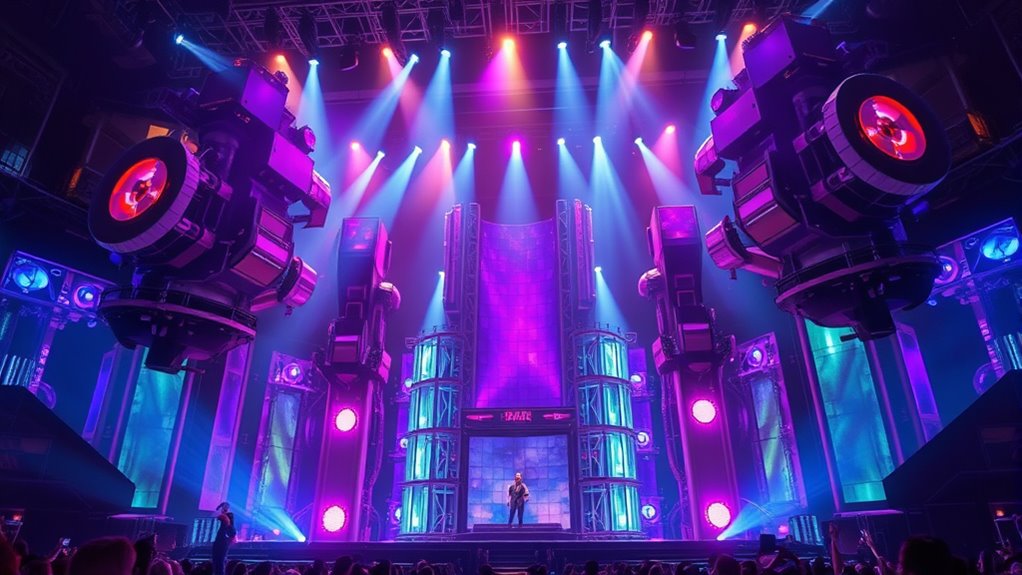
To create a compelling stage, you should incorporate versatile moving set pieces that can transform scenes effortlessly. Integrating lighting effects with these elements enhances their impact and keeps the audience engaged. Customizing props to fit your production’s theme ensures a cohesive and visually striking experience. Incorporating themed props and set pieces inspired by cultural traditions can also enrich the storytelling and captivate your audience.
Versatile Moving Elements
Versatile moving elements are essential for creating engaging and adaptable stage designs. They allow you to transform the environment seamlessly, keeping the audience captivated. Kinetic sculptures add a mesmerizing touch, shifting and rotating to enhance the story’s mood. Movable backdrops provide quick scene changes, immersing viewers in different settings effortlessly. Incorporating dynamic set pieces enables fluid progressions and surprises, making the performance more interactive. You can also integrate automated props that respond to performers’ movements, heightening the sense of immersion. These elements give your stage a lively, unpredictable edge, ensuring each show feels fresh and innovative. When thoughtfully executed, versatile moving components elevate your production, drawing audiences deeper into the experience and showcasing your creative vision. Additionally, understanding stage design concepts can help in planning effective and captivating moving elements that enhance overall production quality.
Integrating Lighting Effects
Have you considered how lighting effects can transform dynamic set pieces and props into mesmerizing visual moments? By incorporating LED screens, you can project vibrant visuals that sync with performers and scene changes, adding depth and atmosphere. Fog effects enhance this illusion, creating layers of mystery and energy that make set pieces feel alive. Use LED screens to display animated backgrounds or thematic imagery, seamlessly blending with physical props. Fog effects can emphasize lighting beams, spotlight key moments, or obscure transitions, making movements feel more dramatic. When combined thoughtfully, these lighting techniques elevate your set design from static to immersive, engaging audiences and amplifying the emotional impact of your live show. The right interplay of lighting, LED screens, and fog creates a mesmerizing, unforgettable experience. Additionally, integrating lighting control systems can help synchronize all visual effects for a cohesive and dynamic show.
Customized Prop Design
Integrating dynamic set pieces and props into your stage design can dramatically enhance visual storytelling. Customized props reflect your unique theatre aesthetics and help convey the story’s mood and themes effectively. Drawing from historical influences allows you to create authentic, immersive experiences that resonate with audiences. These props can be versatile, transforming scenes quickly and adding depth to performances. To maximize impact, consider how each prop aligns with your overall design concept and narrative. Incorporate elements like moving set pieces, interactive objects, or historically inspired artifacts. Thoughtfully designed props not only support storytelling but also elevate the audience’s engagement, making your live show memorable. Remember, well-crafted, customized props are key to crafting a cohesive, immersive stage environment. Additionally, understanding how to prevent damage to set materials ensures your props stay looking their best throughout the production.
Designing for Sightlines and Perspective
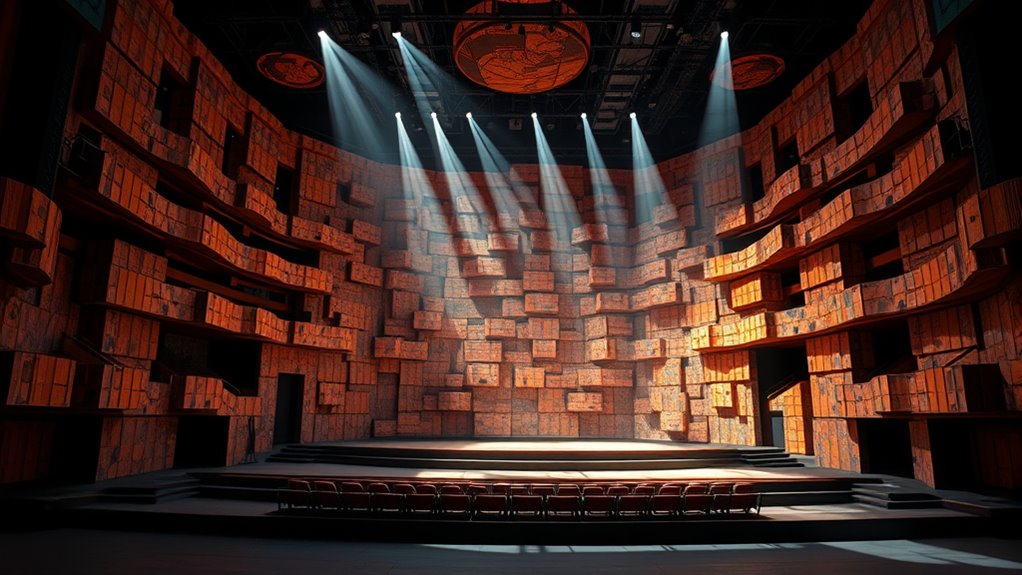
How do you guarantee every audience member has a clear, unobstructed view of the stage? The key lies in designing with sightlines and perspective in mind. You can use optical illusions to manipulate perceived depth, making the stage appear larger or more dynamic from every seat. Visual hierarchies help prioritize focal points, guiding viewers’ eyes naturally toward important elements, regardless of their seat. Elevating platforms or angling set pieces strategically ensures that no one’s view is blocked. Keep sightlines clear by avoiding unnecessary obstructions and considering the audience’s eye level. Thoughtful placement of props and lighting also enhances perspective, creating a seamless experience. Additionally, incorporating focal points ensures that viewers’ attention is directed effectively, regardless of their vantage point. Your goal is to craft a stage that feels immersive from all angles, making every seat the best seat in the house.
Creating Interactive and Multi-Sensory Environments
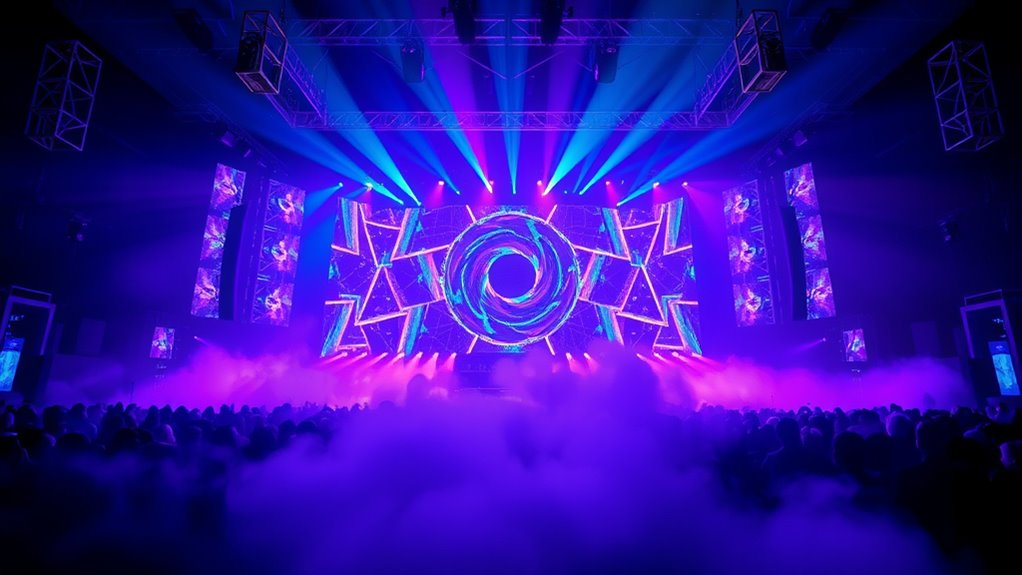
Building on the importance of clear sightlines and perspective, creating an engaging environment also means appealing to multiple senses and encouraging interaction. To boost audience engagement and sensory stimulation, incorporate tactile elements, dynamic lighting, and immersive audio. These features invite attendees to not just watch but feel part of the experience. For example, touch-sensitive surfaces or interactive projections can foster physical engagement, while scent diffusers add an olfactory layer. Use lighting that shifts with the performance to evoke emotion and heighten immersion. Additionally, soundscapes that respond to movement or sound cues deepen the multi-sensory environment. By thoughtfully combining these elements, you craft a stage that captivates all senses, making your live show memorable and deeply engaging.
Employing Color Theory for Emotional Impact
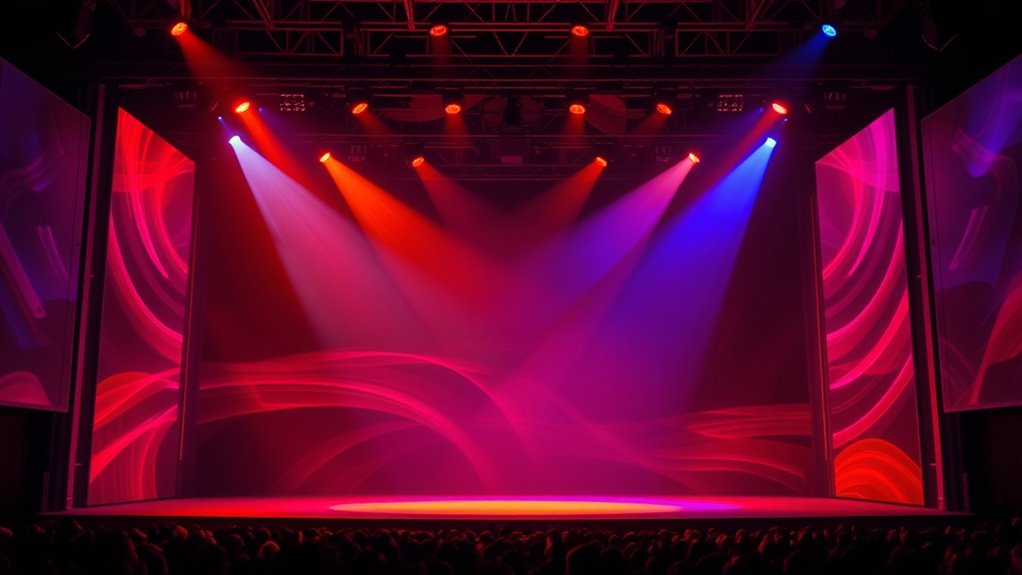
Color is a powerful tool that can evoke specific emotions and set the tone for your stage. By using complementary color schemes, you create visual contrast that captures attention and enhances emotional resonance. For example, pairing warm reds with cool greens can generate excitement or tension, while blue and orange combinations evoke a sense of balance and energy. Understanding color psychology helps you select hues that align with your show’s mood, whether it’s passion, tranquility, or urgency. Carefully chosen colors influence how the audience perceives the atmosphere and deepen their emotional connection. Experimenting with complementary schemes allows you to craft dynamic visuals that support storytelling and amplify the overall immersive experience. Mastering color theory empowers you to design stages that resonate emotionally and leave a lasting impression.
Integrating Technology and Digital Elements
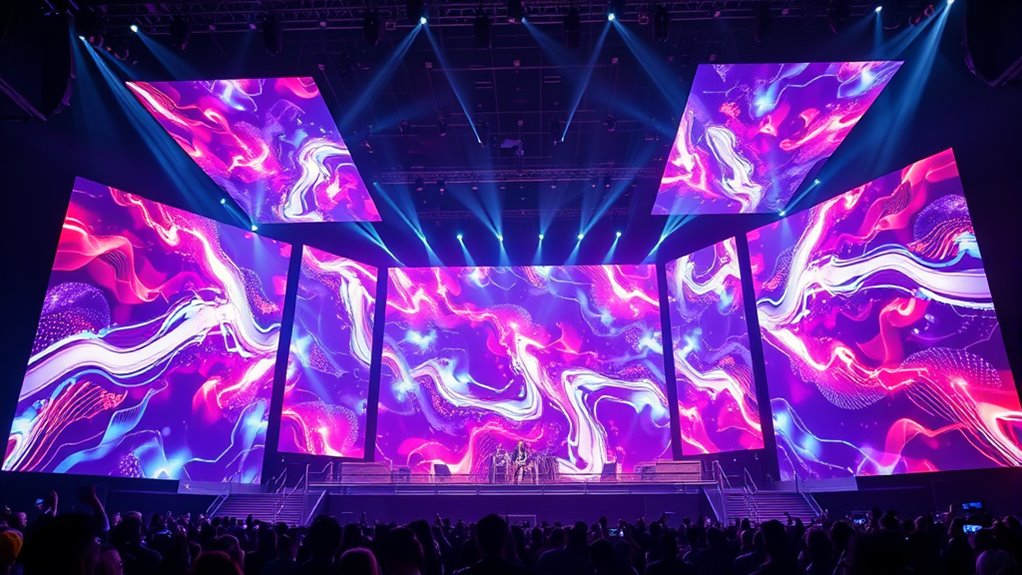
You can enhance your stage design by incorporating interactive visual projections that respond to performers and audience movement. Augmented reality effects add a layer of immersion, transforming the stage into a dynamic environment. Additionally, digital soundscapes can elevate the atmosphere, making your production more engaging and memorable.
Interactive Visual Projections
Have you ever wondered how digital technology can transform a stage into a dynamic, immersive environment? Interactive visual projections do just that by combining projection mapping with compelling visual storytelling. They turn static surfaces into vibrant canvases that respond to performers’ movements and audience interactions. With projection mapping, you can create illusions of depth, motion, and changing scenery that captivate viewers’ attention. These projections add a layer of engagement, making the audience feel part of the story unfolding before them. You can project animated visuals onto set pieces, transforming them seamlessly during the performance. Incorporating interactive visual projections elevates your stage design, making your show more memorable and immersive. They’re a powerful tool to bring your creative vision to life with digital innovation and artistic flair.
Augmented Reality Effects
Augmented reality effects seamlessly blend digital elements with the physical stage, creating an immersive experience that enthralls audiences. By using virtual overlays, you can project dynamic visuals directly onto set pieces or performers, enhancing storytelling and atmosphere. Real-time tracking is essential, as it ensures these digital elements respond instantly to performers’ movements and stage changes. This technology allows you to create interactive environments where virtual objects appear to coexist naturally with physical elements, heightening audience engagement. With AR, you can introduce fantastical landscapes, floating symbols, or animated characters that adapt seamlessly during the performance. Implementing these effects requires precise calibration, but the payoff is a visually stunning, immersive show that feels both innovative and mesmerizing.
Digital Soundscapes Integration
Digital soundscapes have become an essential tool for creating immersive stage environments, seamlessly blending technology with live performance. By leveraging virtual sound design, you can craft layered audio experiences that transport your audience to different worlds. Incorporating immersive audio layers ensures the sound feels multidimensional and dynamic, enhancing storytelling. You can synchronize digital soundscapes with lighting and visuals for a cohesive environment that captivates viewers from every angle. Using advanced software, you manipulate sound to create realistic surroundings or surreal atmospheres, adding depth to your stage design. This integration boosts emotional engagement and elevates the overall experience. Whether for theatrical productions, concerts, or immersive art shows, digital soundscapes revolutionize how audiences connect with live performances.
- Customizable virtual sound design for specific themes
- Spatial audio techniques to enhance realism
- Real-time integration with stage effects
Planning Seamless Transitions Between Scenes
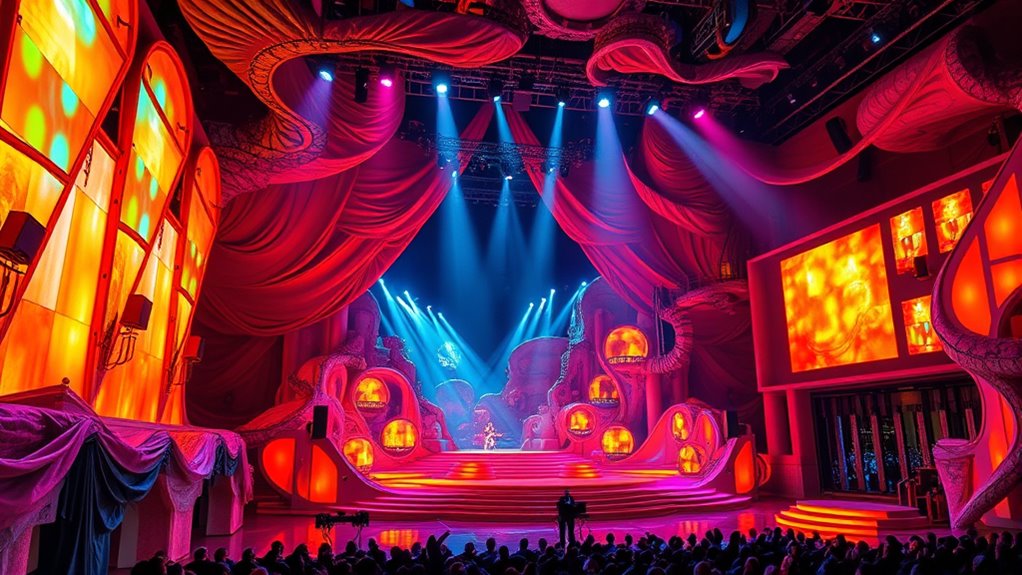
Seamless scene shifts are essential for maintaining the flow and immersion of a production, and planning them carefully can make or break the audience’s experience. To achieve this, focus on costume coordination, so actors can quickly change or adapt outfits with minimal disruption. Effective backstage logistics are also critical; organize props, set pieces, and lighting cues in advance to guarantee smooth transitions. Coordinate timing between costume changes and scene alterations, so nothing feels rushed or awkward. Use rehearsals to identify any bottlenecks and refine your plan. Clear communication between stagehands, costume designers, and performers helps prevent delays. By paying attention to these details, you ensure transitions feel natural and unobtrusive, keeping the audience fully immersed in the story.
Balancing Functionality With Aesthetics
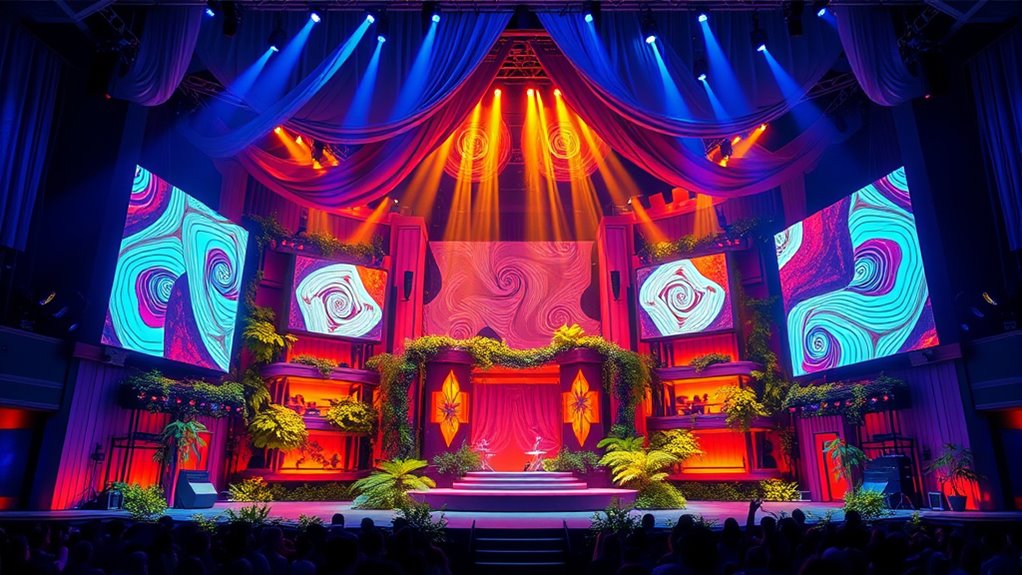
Achieving the right balance between functionality and aesthetics is essential for a stage design that captivates audiences while supporting practical needs. You need a setup that looks stunning but also allows performers to move freely, change costumes smoothly, and manage backstage logistics efficiently.
- Coordinate costumes seamlessly with the stage environment to avoid distractions.
- Design backstage areas that hide technical equipment but are accessible for quick scene changes.
- Use aesthetic elements that enhance the story without hindering performer safety or movement.
Testing and Refining the Design for Maximum Engagement
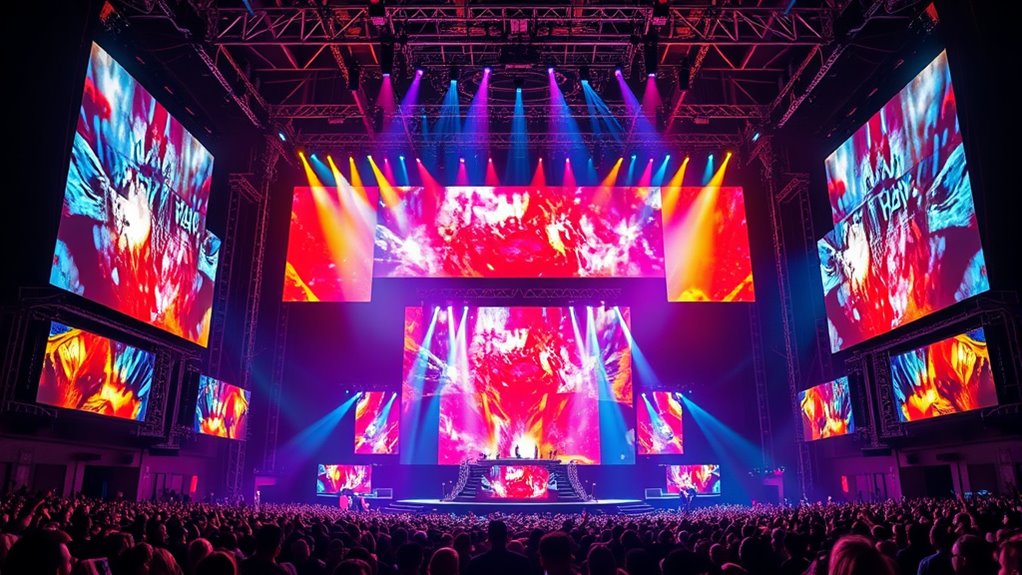
To create a stage design that truly engages your audience, it’s crucial to test and refine your setup through careful observation and feedback. During rehearsals, pay close attention to how the audience responds and gather their feedback. This helps you identify what works and what needs adjustment. Make rehearsal adjustments based on this input, fine-tuning lighting, positioning, and visual elements to maximize engagement. Use the table below to track key aspects:
| Aspect | Feedback/Adjustment |
|---|---|
| Audience visibility | Improve sightlines |
| Lighting effects | Enhance focus points |
| Stage movement | Increase interaction |
| Visual cues | Clarify storytelling |
Refining your design with audience feedback ensures your show resonates deeply and captivates every viewer.
Frequently Asked Questions
How Can Stage Design Enhance Storytelling Beyond Visuals?
You can enhance storytelling by incorporating interactive visuals that respond to the performers and audience, making the experience more dynamic. Use lighting, sound, and set elements to evoke emotions and guide the audience’s focus. Engaging the audience directly increases their involvement, making the story more memorable. By blending visual effects with active audience participation, you create a richer, more immersive narrative that transcends mere visuals and deeply connects everyone.
What Are Cost-Effective Strategies for Innovative Stage Setups?
Think of your stage as a blank canvas waiting to burst with creativity. To keep costs low, you can use budget-friendly fixtures and craft DIY set pieces that transform your space without breaking the bank. Repurposing materials and adding simple lighting effects can create a dynamic, innovative setup. These strategies allow you to experiment and innovate, turning a modest budget into a powerful visual story that captivates your audience.
How Do Safety Considerations Influence Creative Design Choices?
You need to prioritize fire safety and structural integrity when making creative design choices. These safety considerations influence your design options by requiring you to select fire-resistant materials and ensure stable structures. You might innovate with modular setups or hidden support systems that enhance the experience without risking safety. Ultimately, balancing creativity with safety guarantees your audience enjoys the show without compromising their well-being.
What Role Does Acoustics Play in Stage Environment Planning?
Think of your stage as a musical instrument, where acoustics shape every note. You need to prioritize sound optimization and use acoustic treatments to control echo and reverberation. This creates a clear, balanced environment, ensuring every performer’s voice and instrument reach the audience with clarity. By planning for acoustics early, you enhance the overall experience, making your show immersive and engaging without unwanted noise distractions.
How Can Sustainability Be Integrated Into Stage Design?
You can integrate sustainability into stage design by choosing eco-friendly materials that reduce environmental impact. Incorporate renewable energy sources, like solar or wind power, to run equipment efficiently. Consider using recycled or biodegradable set pieces, and design for reusability to minimize waste. By making these conscious choices, you create a greener production that benefits the environment while maintaining an engaging and innovative live show experience.
Conclusion
By mastering these stage design secrets, you can craft immersive live experiences that captivate your audience from start to finish. Did you know that shows with innovative stage design see up to 30% higher audience engagement? When you balance aesthetics with functionality, utilize technology wisely, and plan seamless progressions, you create a memorable atmosphere that keeps viewers hooked. Keep testing and refining your approach to push your show’s immersive potential even further.
